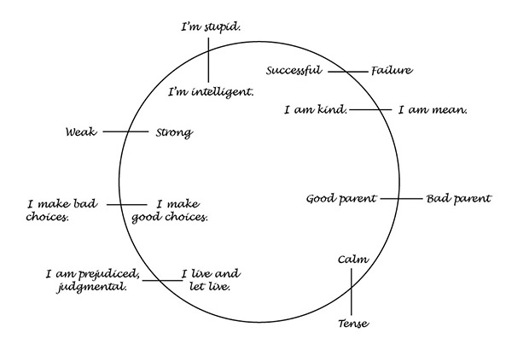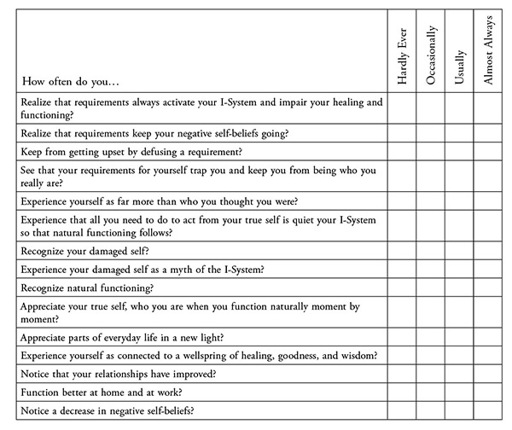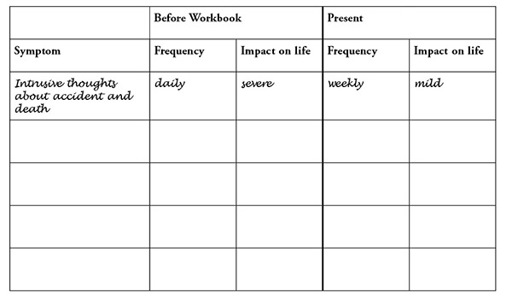Mind-Body Workbook for PTSD (20 page)
Read Mind-Body Workbook for PTSD Online
Authors: Stanley Block

2. Do a Where I Should Be in My Healing Process map. Around the oval, jot any thoughts that come to mind. Work quickly, without editing your thoughts. List your body tensions at the bottom of the map.

Body Tension:
______________________________
______________________________
Looking at the info on your map, fill out this chart:

3. Do this map again using your bridging awareness practices. Before you start writing, listen to background sounds, feel your body’s pressure on your seat, sense your feet on the floor, and feel the pen in your hand. Once you’re settled, keep feeling the pen in your hand, and start writing any thoughts that come to mind. As you write, keep paying attention to background sounds and feeling the pen in your hand, as you watch the ink go onto the paper. Write for several minutes.

- How is this map different from the previous one?
______________________________
______________________________
- This map shows you that you function naturally when your I-System is calm. What do you notice about your sense of self-worth? Are you healing and connecting to your inner wisdom?
______________________________
______________________________
______________________________
Use your mind-body bridging practices in your daily life, being gentle with yourself and noticing what happens. Your life is a series of moment-by-moment events, and when you befriend your I-System, you are in the driver’s seat.
Day Seven Date:____________
Each moment of your life is a presentation. Today, using your mind-body bridging practices, discover who is presenting: your damaged self or your true self? Observe your presentations today.
1.
Damaged self
—List five situations where your I-System was overactive:
_______________
_______________
_______________
2.
True self
—List five situations where your I-System was calm:
_______________
_______________
_______________
3. Can your negative self-beliefs related to your trauma exist when your I-System is at rest?
Yes ____ No ____
4. Do a Who Am I? map. Inside the circle, write the qualities that best describe who you are. After you have listed at least six qualities, outside the circle write the opposite of each quality and connect it with a line. If needed, see the sample map that follows.
Who am I? Map

Sample Map: Who Am I?

- How does each quality inside the circle make you feel?
______________________________
______________________________
______________________________
- How does each quality outside the circle make you feel?
______________________________
______________________________
______________________________
- Do the qualities inside the circle really describe who you are? Yes ____ No ____
- Do the qualities outside the circle really describe who you are? Yes ____ No ____
Your I-System has you believing that the qualities inside the circle define you. Whenever you think you have any of the qualities outside the circle, your I-System tells you you’re lacking or damaged. Your I-System wants to convince you that you are whoyou
think
you are. The qualities you listed are just thoughts, not you. - Using bridging awareness practices and thought labeling, review all the qualities on your map. What happens?
______________________________
______________________________
______________________________
With bridging, you expand the circle to include everything on your map. When you aren’t driven by your requirements, you are
everything
, which means you can have any quality on your map (even negative ones) without activating your I-System.
MBB Weekly Evaluation Scale Heal the Negative Self-Beliefs Trauma Causes
Date: __________
During the past week, how did you do with these practices? Check the description that best matches your practice: hardly ever, occasionally, usually, or almost always.

List three requirements that used to cause you to have a meltdown and that you now deal with by releasing the I-System’s tension and letting yourself function naturally:
______________________________
______________________________
______________________________
7.
Resolve Trauma Memories Step by Step
Completing the exercises in the previous chapters has prepared you for today. You’ve learned tools to quiet and befriend your I-System, building the foundation to tackle your trauma experience. When your I-System is overactive, creating chaos, it may feel like a foe. But you have also come to see it as a friend who alerts you whenever you veer off course from your true self. Now, recognizing early signs of an overactive I-System, using bridging awareness practices, befriending your depressor and fixer, and defusing your requirements are everyday activities. Sometimes your mind-body bridging practices are effortless, and sometimes they take lots of effort; natural functioning can be either way, and natural functioning is what you’re doing more and more of.
To resolve trauma memories, you’ll do a lot of mind-body mapping, which, as you know, is the quick, simple practice of freely jotting your thoughts on paper and noting your body sensations. Mapping gives your naturally functioning awareness the chance to gently notice your active I-System. This chapter introduces an advanced mapping practice called
bubble mapping
, a simple and powerful tool that adds more clarity and reduces your I-System’s emotional distortion.
Day One Date:____________
1. Recall the symptoms related to your trauma that bothered you before you started this workbook. Log those symptoms in the chart below and compare how they were used at the start with how they are now. This list of symptoms might help:
- Having flashbacks—intrusive thoughts, smells, pictures, sounds, sensations, or feelings that pop into your mind about your trauma, as if you were reliving your trauma
- Having flashbacks so intense and powerful that you lose track of where you are
- Having nightmares—intense, startling bad dreams—related to the trauma
- Avoiding situations, thoughts, or feelings related to the trauma
- Feeling numb or unemotional
- Being uninterested in the world around you
- Being in an overstimulated mind-body state (increased arousal, revved up) that results in trouble sleeping or concentrating, irritability, anger, being on guard or easily startled, and restlessness
After logging your symptoms in this chart, rate their frequency as
never
,
weekly
,
2–3x week
, or
daily
; and rate their effect on your life as
none
,
mild
,
moderate
, or
severe
:

